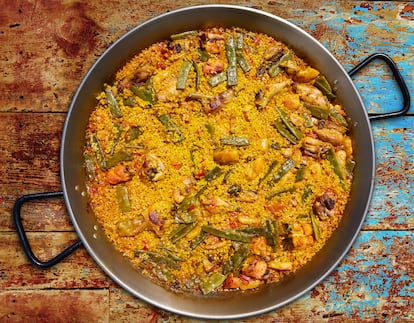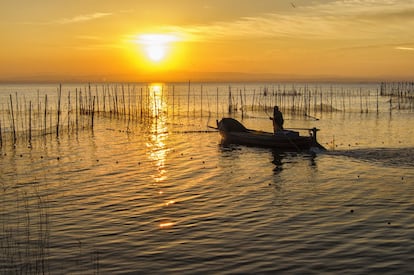Paella gets protected status as part of Valencia’s cultural heritage
Regional government describes the beloved dish as ‘the art of uniting and sharing’ and lays out some of the basic rules for preparing it the traditional way

Paella has been declared by Spain’s regional government of Valencia, where the dish originated, as “an asset of cultural interest” (or BIC in its Spanish acronym), a status affording special legal protection.
A new decree published in the Mediterranean region’s official gazette describes paella as “the art of uniting and sharing.” According to the declaration, paella is at the heart of Valencia’s gastronomic tradition and has become one of the “most prestigious global brands” of Spain.
Paella is not only a dish in itself. Its elaboration and the art involved in its preparation and tasting make it a true social phenomenonValencia government decree
As part of the recognition, the paella’s origins have been officially established as emerging from the wetlands of La Albufera, “where the dish was cooked in order to sustain the peasants and farmers in the area.” At the end of the 19th century, Valencian paella was exported from the farmhouses to the eating houses and picnic areas around Malvarrosa beach, the Grao district of Castellón and the Albufereta neighborhood of Alicante.
“Without a doubt this emblematic dish, which is at the core of traditional Valencian cuisine, represents togetherness and is a fundamental cornerstone of the Valencian region’s gastronomy… Paella is not only a dish in itself. Its elaboration and the art involved in its preparation and tasting make it a true social phenomenon, even shaping aspects of the landscape and ecosystem of the Valencian region due to the cultivation and harvesting of the food with which it is made.”
The decree was approved on October 29 following a request from Valencia’s City Council. As well as being declared an asset of cultural interest, the paella is now protected by a series of additional measures, including further studies and documentation work to ensure that the knowledge is passed on to future generations.
Origins of the dish

The origins of the dish are traced back to 330 BC, when Alexander the Great brought rice to Europe. “However, rice was not grown in large quantities in Valencia until the arrival of the Arabs who introduced improvements in cultivation techniques and irrigation systems on the eastern coast of Spain,” states the decree.
In the 16th century, the playwright Francisco de Paula Martí wrote in a small treatise attached as an appendix to the General Agriculture Study by Gabriel Alonso de Herrera that “the Valencians have the arrogance, well founded in my opinion, [to believe] that no one has come to know how to season [rice] better than they do, nor in such various ways (...) It is not strange that the Valencians have achieved a degree of perfection in this aspect, unknown in the other provinces, because they sustain themselves almost exclusively with this food, particularly those without great means, and so they have studied how to make it more pleasing to the palate.”
De Paula added: “Everywhere people have wanted to imitate them and, in a bid to do so, they usually leave it half-cooked, mistakenly calling it Valencian rice, as they are under the impression that the natives eat it almost raw, having observed that the cooked grains remained whole and separated in the Valencian dishes.”
In the 18th century, the first reference to paella or “Valencia-style rice” popped up in a manuscript of recipes, explaining the techniques for its preparation, including the remark that the rice must be dry. And in 1896, the French cinematographer Eugène Lixse filmed the preparation of a paella for the first time.
In the 20th century, this traditional dish began to catch on in the big cities and reached its zenith with the tourist boom in the 1960s, when foreign tourists flooded into the country to spend their vacations on the coast.
The decree does not provide the recipe for paella because “there are many versions and styles,” but it does give some broad suggestions regarding its preparation. For example, it flags up the practice of adding rice to the broth by “forming a cross so that the amount is distributed equally in the paella; and. if the number of diners allows, the layer of this ingredient should be thin.” Another tip states that “it is advisable not to stir the rice while it is cooking, as it contains starch, a thickening element present in cereal, which is not desirable if you want the grain of the paella to be loose.”
According to the Valencia government’s declaration, tradition dictates that paella should be eaten with a wooden spoon, “although today this custom is no longer widely practiced and it is left to the choice of each diner.”
But it is the ritual around the preparation of the dish that makes it a peculiarly Valencian social icon. “Virtually any major event that takes place in the Valencia region has this delicacy at its heart, as it is indicative of festivity and cohesion, largely due to the humble dish’s simplicity. The custom of involving the diners in its preparation, within a festive framework, makes it a symbol of the Valencian people.”
After granting paella cultural protection, regional authorities now wish to take the matter further and “have our iconic dish declared part of the world’s intangible heritage by the United Nations Educational, Scientific and Cultural Organization.”
Tu suscripción se está usando en otro dispositivo
¿Quieres añadir otro usuario a tu suscripción?
Si continúas leyendo en este dispositivo, no se podrá leer en el otro.
FlechaTu suscripción se está usando en otro dispositivo y solo puedes acceder a EL PAÍS desde un dispositivo a la vez.
Si quieres compartir tu cuenta, cambia tu suscripción a la modalidad Premium, así podrás añadir otro usuario. Cada uno accederá con su propia cuenta de email, lo que os permitirá personalizar vuestra experiencia en EL PAÍS.
¿Tienes una suscripción de empresa? Accede aquí para contratar más cuentas.
En el caso de no saber quién está usando tu cuenta, te recomendamos cambiar tu contraseña aquí.
Si decides continuar compartiendo tu cuenta, este mensaje se mostrará en tu dispositivo y en el de la otra persona que está usando tu cuenta de forma indefinida, afectando a tu experiencia de lectura. Puedes consultar aquí los términos y condiciones de la suscripción digital.
More information
Últimas noticias
Maduro pleads not guilty before the federal court in New York: ‘I am still the president of Venezuela’
A new test can detect Alzheimer’s from a finger prick
UN team enters Sudanese city of El Fasher after paramilitary massacre: ‘It’s like a ghost town’
A recipe for resistance: Indigenous peoples politicize their struggles from the kitchen
Most viewed
- Gilles Lipovetsky: ‘If you want to live better and fall in love, take Prozac, don’t look to philosophy’
- Alain Aspect, Nobel laureate in physics: ‘Einstein was so smart that he would have had to recognize quantum entanglement’
- Alvin Hellerstein, a 92-year-old judge appointed by Bill Clinton, to preside over Maduro’s trial in New York
- Why oil has been at the center of Venezuela-US conflicts for decades
- Maduro’s downfall puts China’s relationship with Venezuela to the test










































